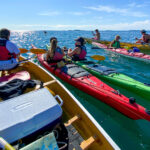Reach for the next turn
Good skiers show a wide range of movement, but without coaching those movements can be misinterpreted. A good example is the situation pictured, where the skier is coming onto a flatter section at high speed. The body bends in the transition, but the extension of the legs is a reaching movement to maintain contact with the snow. There’s very little pressure in frame 3 and 4. This skill can be learned at slower speeds by using rolls in the terrain. Flex near the top and then stretch the feet out to keep the skis’ edges biting as the turn builds.
Shaped skis have caused the use of poles to fall out of fashion for some reason. Maybe it’s because a firm pole plant is not as important for basic technique as it was in the day of long, straight skis. That’s too bad, because a good pole plant is as critical as ever in situations that call for rotational stability, as in this example of short turns in small bumps. By firmly planting the pole the upper body is stabilized, allowing feet to move quickly to the new edges. Angle the pole so the basket is forward, with your thumb pointing in the direction of travel. Good coaches and instructors teach upper-body discipline—and that includes a pole plant in every short-radius turn.
Follow the arrows
This view of Misayo on a steep slope reveals one of the keys to effective speed control. Imaginary arrows depict how much she’s facing down the slope. This body attitude allows strong edging as well as quick switches to new edges. Focus on a target well down the slope and concentrate on keeping your hands forward, especially your uphill arm and shoulder
Lighten up in the crud
It’s easy to say “stand in the middle of the skis” or “maintain forward pressure,” but sometimes nature doesn’t co-operate. It’s hard to believe, but even at Silver Star there are days when the conditions aren’t perfect. These photos were shot after strong overnight winds had churned 30 cm of powder into white lava, which varied from soft holes to ridges the consistency of peanut brittle. Conditions like these challenge the best skiers because the winning strategy is to be forceful in the edging phase, but light as a feather at the transition. These two images capture it perfectly. Notice: weight back and feet pulled up to clear the crud for the next turn.
Ankle skiing
Italian technical star Denise Karbon is often used as an example of supreme balance and timing in GS and slalom. But this sequence also shows a more subtle but important element of skiing that all skiers who have graduated from the bunny hill can learn from. Between frame 2 and 4 she moves her ankles from fully flexed to upright, allowing her feet to move freely under her body to maintain amazing balance. Many recreational skiers ski with ankles fixed, locking out the important “balancing joint.” Take a run focusing on moving your feet under your body by flexing the ankles. Your balance will improve dramatically.



